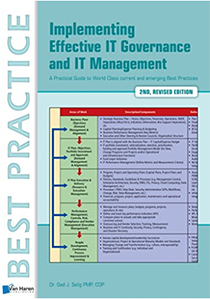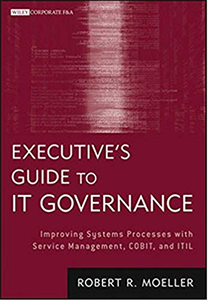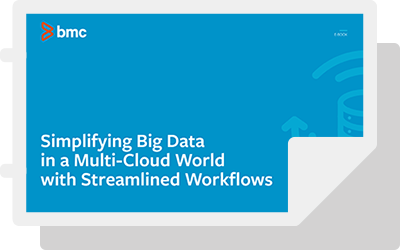For executives on-the-go, there isn’t much you can’t accomplish quickly. Mobile technology has executives far more connected than ever before, making critical decisions at a touch of a button. But unfortunately, there’s no fast and easy way to handle IT governance.
IT governance refers to a business’s set of established processes that ensure IT resources are being used efficiently while being resourced to the appropriate goals and priorities. Businesses can stay on top of governance in a number of ways while using several philosophies, like ITIL, coloring CIO perceptions around IT governance.
And while c-suite executives receive guidance from a number of places, when it comes to IT governance, a popular way to learn about it is to dive in the old fashioned way—through a good book. At BMC, we believe proper IT governance serves as a critical cornerstone of a solid overall business model. This is compounded by the fact that almost every business operates in a multi-cloud fashion in today’s fast-paced, digital business climate.
Using a patchwork approach, businesses have the freedom to pick and choose which digital services make the most sense for their business model. But with that comes new implications for the governance of IT organizations. For example, “managing vendor relationships” are now taking a front-seat in conversations about governance than ever before.
With that said, some concepts in IT governance are timeless. That’s why we are recommending these five books, old and new, for your reading pleasure. Don’t get stuck in a governance rut! Read these books instead, and be sure to also check out my list of top Digital Transformation books:
- IT Governance: How to Reduce Costs and Improve Data Quality through the Implementation of IT Governance by Helmut Schindlwick
- The CIO Paradox: Battling the Contradictions of IT Leadership by Martha Heller
- Real Business of IT: How CIOs Create and Communicate Value by Richard Hunter and George Westerman
- Implementing Effective IT Governance And IT Management by Van Haren Publishing
- Executive’s Guide to IT Governance: Improving Systems Processes with Service Management, COBIT, and ITIL by Robert R. Moeller
IT Governance: How to Reduce Costs and Improve Data Quality Through the Implementation of IT Governance
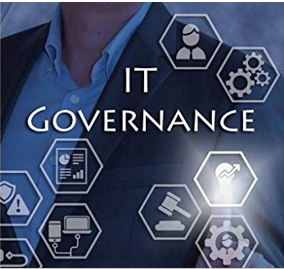
Helmut Schindlwick
IT Governance: How to Reduce Costs and Improve Data Quality through the Implementation of IT is a newer book to make the must-read list, as it was published in 2017. Helmut Schindlwick is particularly authoritative on the subject since he has certifications in ITIL, COBIT, Prince2, and ISO 27002, to name a few. Schindlwick received an IT degree in 1999, and he then earned a graduate degree in Business Administration. He has a deep understanding of both technical and operational aspects of governance, which makes his style refreshing.
Readers are dazzled by his detailed and thorough perspective on governance, and his data-centric focus. Schindlwick masterfully demystifies an ambiguous topic, how to manage big data in a comprehensible way. People enjoyed Schindlwick’s signature TESy Framework, which is essentially a wireframe that illustrates the kinds of dependencies that IT decisions affect. When reading this book, it’s recommended you frequently reference the framework diagram as you navigate the book for bigger picture application.
The CIO Paradox: Battling the Contradictions of IT Leadership
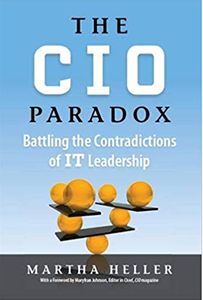
Martha Heller
The CIO Paradox: Battling the Contradictions of IT Leadership, published in late 2012, was written by Martha Heller. While the book is just over 6 years old, many of Heller’s lessons regarding leadership are still relevant today. For example, Heller suggests that a troubling concern of today’s businesses is they lack IT leadership, meaning the absence of a CIO.
The allusive CIO is a non-employed or underemployed position for enterprise businesses, causing discourse throughout organizational cultures relying on the balance of the delicate balance of scales of IT leadership and a technical vision. Hence, the CIO paradox is one where without a competent CIO, businesses suffer complications or lack of growth they otherwise wouldn’t if they invested in strong leadership.
But that’s not the only paradox. Heller masterfully lays out a wanton collection of paradoxes that add to the totality of being a CIO. By reading Heller’s book, present and future CIOs can avoid common pitfalls and traps that occur as a result of the nature of the position.
Real Business of IT: How CIOs Create and Communicate Value
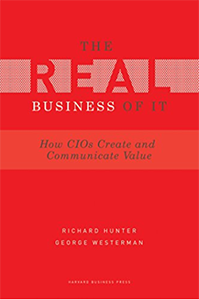
Richard Hunter and George Westerman
It’s hard to say if there’s been another book quite as impactful for the c-level executive as Real Business of IT: How CIOs Create and Communicate Value by Richard Hunter and George Westerman. Published in 2009, the book offers everyday strategies for executives to learn to discuss their overall business impact in ways that other managing stakeholders are sure to understand.
Richard Hunter is a Group Vice President for Gartner Research, and George Westerman is a research scientist at MIT. The two have substantial real-world experience from which to draw for this Gartner-endorsed book. They implement their unique expertise to impart rare advice regarding the monetary, personal, and investment value that proper IT governance creates within an organization. Armed with this knowledge, a CFO or CIO can up their game for the better of the organization.
Implementing Effective IT Governance And IT Management
Van Haren Publishing
If you couldn’t tell from the name, Implementing Effective It Governance and It Management by Van Haren Publishing is a simple best practice guide. But sometimes simplicity is just what you need, especially when dealing with complex topics.
When confronting IT governance issues, leadership often struggles with the alignment between the various departments that rely upon one another. Positive communication is key.
Communication among organizational compartments is a focus offered in this book. The book addresses best practices, focusing on offering a solution to part of the larger alignment issue. But this guide isn’t meant to be used in a one-off, situational way. What’s composed in its pages is a larger structural framework that integrates the individual components of IT governance, such as strategic planning, demand management, performance management, strategic sourcing, and more.
For readers looking to apply a quick fix to a governance fire, this may not be the right book. Because of the holistic approach to various interdependent components, it can be difficult to find an answer on the fly. But if you’re looking for the most efficient and effective approach to IT (and you should be), start here.
Executive’s Guide to IT Governance: Improving Systems Processes with Service Management, COBIT, and ITIL
Robert R. Moeller
For anyone embarking on an exploration of IT management philosophies, reading the Executive’s Guide to IT Governance: Improving Systems Processes with Service Management is a no-brainer. Robert Moeller has a long career establishing himself as an authority in the world of service management. He has a degree in Engineering, and an MBA from the University of Chicago, the city where he currently resides. Moeller is a project manager and audit specialist with certifications including CPA, CISA, PMP, and CISSP.
This book, unlike the others, provides both comprehensive discussions as well as a quick reference guide. You can effectively use it as either independently. Additionally, it’s beneficial for managerial employees up through c-suite executives.
The book was published in 2013, a time of flux in the business sector. At that time, businesses were facing cloud computing and storage, and management changes were introduced in light of such new technology. Readers benefit from Moeller’s informational, no-nonsense approach to laying out a framework for IT and operational success.

